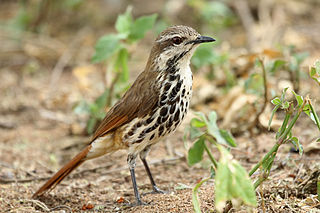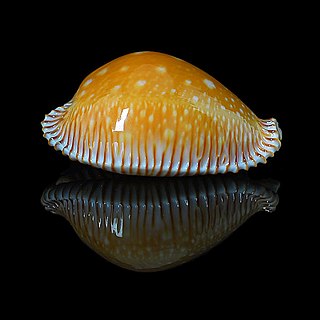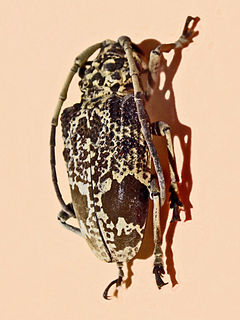Related Research Articles

The zebra finch is the most common estrildid finch of Central Australia and ranges over most of the continent, avoiding only the cool moist south and some areas of the tropical far north. It can also be found natively on Timor island. The bird has been introduced to Puerto Rico and Portugal.

Cattleya is a genus of orchids from Costa Rica south to Argentina. The genus is abbreviated C in trade journals.

The spotted whistling duck is a member of the duck family Anatidae.

The spotted turtle, the only species of the genus Clemmys, is a small, semi-aquatic turtle that reaches a carapace length of 8–12 cm (3.1–4.7 in) upon adulthood. Their broad, smooth, low dark-colored upper shell, or carapace, ranges in its exact colour from black to a bluish black with a number of tiny yellow round spots. The spotting patterning extends from the head, to the neck and out onto the limbs. Sexually mature males have a concave plastron and a long, thick tail. By contrast, sexually mature females possess a flat plastron and have a tail notable shorter and thinner than mature males. Mature males also have a dark iris and face; females typically have a yellow or orange iris and a similarly coloured face that is distinctly lighter than males. Juveniles appear female-like in this regard and at maturity males begin to develop darker features.

Erythranthe guttata, with the common names seep monkeyflower and common yellow monkeyflower, is a yellow bee-pollinated annual or perennial plant. It was formerly known as Mimulus guttatus.

Elaphe is a genus of snakes in the family Colubridae. Elaphe is one of the main genera of the rat snakes, which are found in many regions of the northern hemisphere. Elaphe species are medium to large constrictors by nature. Although all of the species in Elaphe are nonvenomous, bites from rat snakes are still irritably painful and can potentially cause bacterial infections due to the saliva.

Tuberaria guttata, the spotted rock-rose or annual rock-rose, is an annual plant of the Mediterranean region which also occurs very locally in Wales and Ireland. The flowers are very variable with the characteristic spot at the base of the petal very variable in size and intensity of colour.

Romalea is a genus of grasshoppers native to the south-eastern and south-central United States. It is monotypic with a single species, Romalea microptera, known commonly as the eastern lubber grasshopper, Florida lubber, and Florida lubber grasshopper. It is the most distinctive grasshopper species within the south-eastern United States, and is well known both for its size and its unique coloration. It can reach nearly 3 inches (8 cm) in size.

Phyllactinia guttata is a species of fungus in the family Erysiphaceae; the anamorph of this species is Ovulariopsis moricola. A plant pathogen distributed in temperate regions, P. guttata causes a powdery mildew on leaves and stems on a broad range of host plants; many records of infection are from Corylus species, like filbert and hazel. Once thought to be conspecific with Phyllactinia chorisiae, a 1997 study proved that they are in fact separate species.

The speckled chachalaca is a species of bird in the family Cracidae. It is found in forests and woodlands in the western Amazon Basin. It has distinct white scaling/spotting on the lower neck and chest, but otherwise it resembles other chachalacas, it being vaguely pheasant-like, and with an overall brown plumage.

The western bowerbird is a species of bird in the family Ptilonorhynchidae. The species is a common endemic of Australia. It has a disjunct distribution, occurring in Central Australia and the Pilbara region of Western Australia.

The spotted palm thrush, also known as the spotted morning-thrush, is a species of bird in the family Muscicapidae. It is found in Ethiopia, Kenya, Somalia, Sudan, Tanzania, and Uganda. Its natural habitats are subtropical or tropical dry forests, dry savanna, and subtropical or tropical moist shrubland.

The spotted ground thrush is a species of bird in the family Turdidae. It is found in the Democratic Republic of the Congo, Kenya, Malawi, South Africa, Sudan, Tanzania, and possibly Mozambique.

Perisserosa guttata, common name the drop-covered cowry, is a species of sea snail, a marine gastropod mollusk in the family Cypraeidae, the cowries.

Parnara bada, the African straight swift, grey swift or Ceylon swift, is a butterfly of the family Hesperiidae. It is found in south-east Asia, from India through China to Indonesia, as well as the north-east coast of Australia.

Phrynetini is a tribe of longhorn beetles of the subfamily Lamiinae. It was described by Thomson in 1864.
Paraphryneta is a genus of longhorn beetles of the subfamily Lamiinae, containing the following species:
Paraphryneta allardi is a species of beetle in the family Cerambycidae. It was described by Stephan von Breuning in 1970.
Paraphryneta rubeta is a species of beetle in the family Cerambycidae. It was described by Stephan von Breuning in 1947.
Allison's emo skink is a species of lizard in the family Scincidae. It is found in Papua New Guinea.
References
- ↑ BioLib.cz - Paraphryneta guttata. Retrieved on 8 September 2014.
| This Phrynetini article is a stub. You can help Wikipedia by expanding it. |